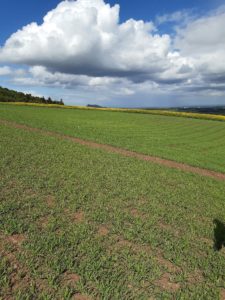Managing Disease Risks in Spring Barley 2022
12 May 2022Spring barley crops have brairded well and nice even emergence and good plant counts are the norm. For the most part Scottish crops have had just enough moisture in contrast with some patchier crops south of the border. Early drilled crops are well tillered, although some are a little pale but should green up nicely after rain.
Disease risks at these early stages of spring barley growth are fairly low but, with grain prices and establishment costs high, managing disease in a targeted way is clearly important. T1 fungicide applications are preventative and designed to keep the crop clean until the more critical T2 application where the main aim is protecting against ramularia. In a dry season and in more resistant varieties then a T1 fungicide can often be insurance only, but if the weather turns wet then the risk that rhynchosporium creeps in rises. Rates of fungicide can be lower than in the winter crop and a low rate mix of an azole and SDHI mix will give broad spectrum of activity and the use of a mix also helps to reduce the risk that resistance develops in target diseases. Late tillering up to the start of stem extension is a good timing for first fungicides – the crop grows so rapidly that waiting until the crop is extending means it will be a very short gap until the more critical T2 fungicides at booting to ear emergence.
Ramularia risk in 2022 will depend on environmental conditions between brairding and ear emergence, and if it is warm and wet the risk increases. But another important driver of ramularia is stress. Some of the stresses to spring barley crops are unavoidable (e.g. flowering or bursts of sunshine) but complex tank mixes are one example of an avoidable crop stress. Herbicides, trace elements, fungicides and growth regulator might be part of the planned inputs but try to avoid six and seven way mixes and separate out in to two passes if necessary.
Ramularia has a bad track record of developing resistance to fungicides and at the moment we are reliant on azoles. Prothioconazole has some efficacy as does mefentrifluconazole which leads in trials. Using these in mix with a strobilurin or SDHI will help to manage other foliar diseases, which is important, but will not help much with the ramularia which is widely resistant to those actives. Relying on a single active is never great and so the big debate is around the addition of the multisite fungicide folpet in support. Although trial results are inconsistent, it does best when used in otherwise robust programmes so adding to T2 treatments is an option and using it at T1 and T2 may be merited where there is a strong history of ramularia on the farm, or if the season pans out as high risk.
Fiona Burnett, SRUC for the Farm Advisory Service
Sign up to the FAS newsletter
Receive updates on news, events and publications from Scotland’s Farm Advisory Service


